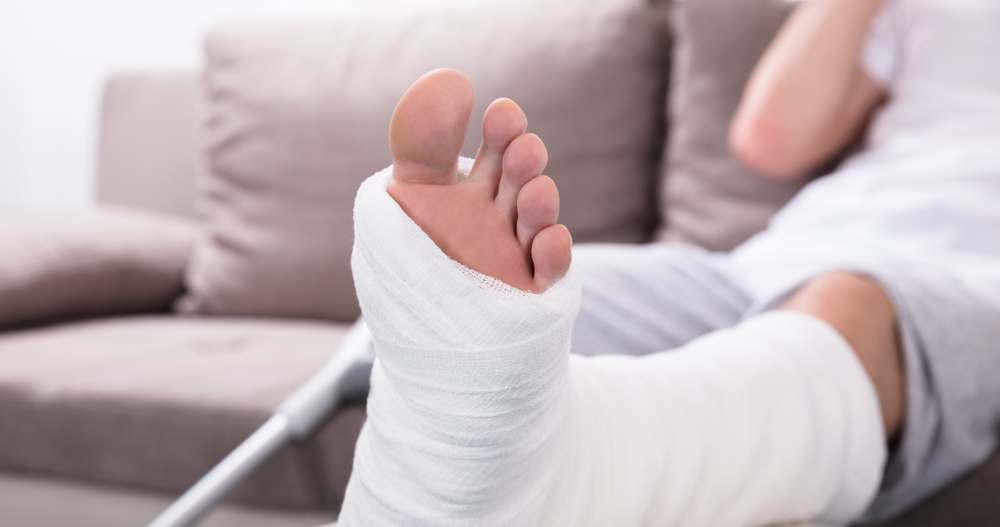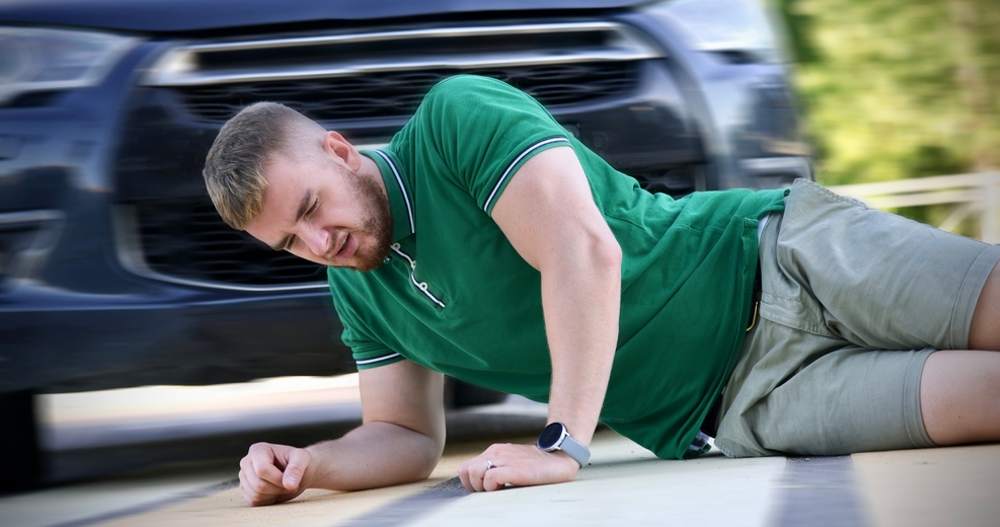A pedestrian collision is when an automotive vehicle hits, or collides with, a person who is on foot. Pedestrian accidents can be extremely scary and overwhelming. They have the potential for severe injuries due to the size and force difference between a human body and an automobile.
Our doctors and staff at AICA Orthopedics Tucker see accident victims every day. If you or a loved one has been in a pedestrian accident, please call us today to set up your evaluation with experts who know how to handle and treat pedestrian injuries.
6 Most Common Pedestrian Injuries
 There are a variety of injuries you can receive when involved in a pedestrian incident. Studies show there is a distinct divide in the most common type of injury based on age.
There are a variety of injuries you can receive when involved in a pedestrian incident. Studies show there is a distinct divide in the most common type of injury based on age.
This is because most injuries are caused when the front bumper of the vehicle strikes the pedestrian. In pediatric patients, the bumper is closer to head height, resulting in a higher rate of traumatic brain injuries. In contrast, adult patients are more likely to be struck between the hip and knee, resulting in a higher incidence of musculoskeletal injuries.
Unfortunately, pedestrian injuries and fatalities remain high. In 2020, 6,516 pedestrians were killed, and an estimated 55,000 pedestrians were injured nationwide. Below we have compiled a list of the six most common pedestrian injuries following an incident with a motor vehicle.
Head and Brain Injuries
Head and brain injuries occur when you suffer a blow to the head or even a sudden jolt or stop causing the brain to bounce off the inside of your skull. The most common immediate result of a pedestrian head injury is loss of consciousness. This is only one sign of injury.
You can also suffer a subarachnoid hemorrhage, concussion, skull fracture, or other traumatic brain injuries. Traumatic brain injuries (TBI) can result in lifelong health challenges. Unlike a cyclist, a pedestrian isn’t wearing a helmet to protect the head and brain from injury.
Symptoms of a TBI or other brain injuries include bleeding, loss of consciousness, headaches, vomiting, nausea, dizziness, trouble concentrating, and even sleep disturbances. Our neurologists at AICA Orthopedics can evaluate you if you are dealing with any of these symptoms.
Spinal Cord Injuries
Spinal cord injuries can be isolated or in conjunction with head/brain injuries. Spinal cord injuries are overwhelmingly caused by car accidents but are also highly reported in pedestrian accidents every year.
A spinal cord injury can range in severity, from minor to completely life-altering. Spinal cord injuries can often result in partial or total paralysis or even death. Death is typically the result of damage higher in the spine near the base of the head and brain.
Due to their height, pediatric victims are more likely to suffer from head, brain, and spinal cord injuries when struck by a vehicle when compared to adult victims.
Broken/Fractured Bones
Broken or fractured bones often happen when extreme force is applied to the bone. A vehicle hitting an unprotected pedestrian has a high likelihood of broken bones to occur. The most common breaks resulting from a pedestrian accident occur in the extremities.
The lower extremities in adults usually suffer fractures as a result of the bumper striking the pedestrian there first. Fractures to the upper extremities are more likely when a victim falls on their arms or shoulders after being struck. If struck by a taller vehicle, you might also see rib fractures.
Soft Tissue Damage
The impact of a pedestrian accident can cause several types of soft tissue damage. The impact can cause blood vessels to burst and result in bruising and severe bruising can develop into hematomas. Cuts, scrapes, sprain, and ligament injuries can also result from pedestrian incidents.
Soft tissue injuries like bruising, cuts, and scrapes have a relatively fast healing time, but something more severe like ligament or tendon tears can require surgery and a longer recovery period.
Organ Damage and Internal Injury
While some internal injuries may not be immediately apparent, symptoms will develop and, depending on the severity, will indicate a course of treatment. Common types of internal injury and organ damage are:
- Ruptured Spleen – usually caused by blunt force trauma to the upper abdomen. A ruptured spleen can result in devastating internal bleeding. It may need to be treated with surgery or just monitored with rest.
- Internal Bleeding – occurs when blood vessels are torn and begin to bleed into your abdominal or chest cavity. Not always noticeable externally, so monitor for symptoms such as nausea, dizziness, abdominal tightness, or urinating blood.
- Chest Injury – this can be internal bleeding that places pressure on the lungs and heart, resulting in shortness of breath, reduced heart rate, and even death. Another potential chest injury is a pneumothorax, or collapsed lung.
Amputations
Regardless if an accident occurs and high-speed or low-speed amputations are always a possibility in pedestrian accidents. Vehicles have sharp metal that can rend flesh easily. Another possibility is a limb getting trapped or pinned by a wheel or other part of the car and the force separating the limb from the body.
Common Locations of Pedestrian Incidents
 Pedestrian incidents occur most frequently in areas that vehicles and pedestrians can occupy at the same time. The following are common locations for pedestrian incidents.
Pedestrian incidents occur most frequently in areas that vehicles and pedestrians can occupy at the same time. The following are common locations for pedestrian incidents.
- Crosswalk – is a common location for pedestrian accidents. Usually happens when a driver is making a left-hand turn. Other contributing factors include: low light, distracted drivers, and pedestrians not following the walk or do not walk signs. Always make sure it is safe to cross and pay attention while crossing a street.
- Parking lots – are complex areas with low visibility. Drivers backing out of parking spaces often have large blind spots and don’t see pedestrians until it is too late. This can occur when pulling out of a spot, but there is a lower incidence of hitting someone when pulling out of a spot. Pedestrians should remain alert and watch for reverse lights on nearby cars.
3 Tips for Preventing Pedestrian Incidents and Injuries
Regardless of who is at fault, the pedestrian or driver, an incident involving a vehicle of any type, can have severe consequences. Both pedestrians and drivers should be vigilant while traveling on and near sidewalks and roads.
Visibility
As a pedestrian, you should make sure you are wearing high-visibility clothing such as a reflective vest and bright colors. This is especially important at low light times and if there is no sidewalk to run or walk on.
Vehicles should utilize the lights on your vehicle. During the day, if you have running lights and at night, turn on your headlights. If making a turn, use your indicator light.
Appropriate Locations
Pedestrians should, when available, use designated pedestrian areas. This includes sidewalks for walking and running, marked crosswalks when traversing a road, and facing oncoming traffic if there is no sidewalk and you have to use a road.
Operators of vehicles should obey posted signage and drive only where permitted by law.
Predictability
Cars and other vehicles do not have the ability to respond quickly to sudden moves by pedestrians. Pedestrians follow posted signage and always look both ways.
Similar to pedestrians, cars can startle pedestrians, and pedestrians move at a highly reduced speed in comparison to vehicles.
Diagnosing and Treating Pedestrian Injuries
If you have been involved in a pedestrian versus vehicle incident, it is important to seek medical treatment immediately. However, some injuries are not always apparent right away. Our team at AICA Orthopedics uses state-of-the-art testing and imaging to diagnose your injuries to develop the best treatment plan.
X-ray
An x-ray is a form of medical imaging that allows doctors to see highly calcified structures such as bone and teeth. You might have an x-ray completed to identify any fractures or dislocations suffered after a pedestrian accident.
MRI (magnetic resonance imaging)
Soft tissues, nerves, and blood vessels can be evaluated with an MRI. If our doctors suspect a spinal injury or a torn ligament, they might order an MRI to evaluate the location and severity of these injuries.
CT (computed tomography)
A CT scan is similar to an x-ray but has a much higher resolution and also shows soft tissue injuries. CT scans are frequently used in trauma, like pedestrian accidents, due to their speed and level of detail.
Contact AICA
If you are involved in a pedestrian incident, promptly seeking medical intervention is vital. Seeking evaluation quickly will help your doctors determine the presence and severity of your injury.
If you are experiencing any signs and symptoms mentioned above, especially shortness of breath, dizziness, persistent bruising,d or pain, you should see a doctor as soon as possible.
At AICA Orthopedics Tucker, we treat car and pedestrian accident injuries every day. We can get you on the path to feeling better!
Following diagnosis and treatment, our orthopedic doctors can collaborate with our physical therapists and chiropractors to develop a treatment plan. Physical therapy can improve strength and flexibility, and a visit with a chiropractor can help alleviate pain while you are healing. Early medical attention leads to faster healing times, so please contact AICA Orthopedic today!
